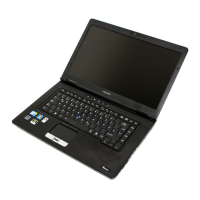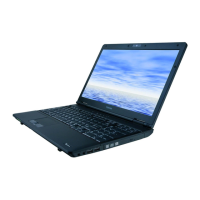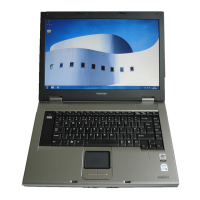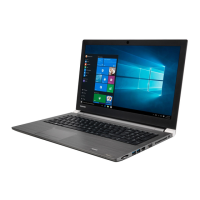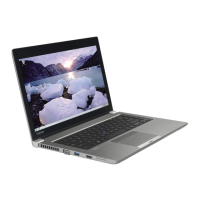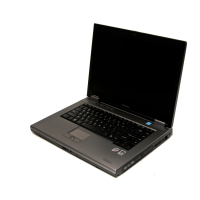
Do you have a question about the Toshiba TECRA A10/S10/M10/SATELLITEPRO S300 TECRA S10 and is the answer not in the manual?
| CPU | Intel Core 2 Duo |
|---|---|
| Graphics | Intel GMA 4500MHD |
| LAN | Gigabit Ethernet |
| Chipset | Intel GM45 Express |
| Display | 15.4-inch WXGA |
| Optical Drive | DVD SuperMulti |
| Wireless | Wi-Fi 802.11a/b/g/n |
| Operating System | Windows Vista |
| Battery | 6-cell Li-ion |
| Weight | 2.7 kg |
| Ports | USB 2.0, VGA, ExpressCard, SD card reader |
Outlines important safety measures and precautions for using the computer.
Lists essential hardware items included with the computer for initial setup.
Details the physical components of the computer provided in the package.
Lists the pre-installed Windows operating system and utility software.
Lists the manuals and documentation provided with the computer.
Step-by-step guide on how to connect the AC adapter for power.
Instructions on how to open the computer's display panel safely.
Procedure for powering on the computer for the first time.
Explains modes for shutting down the computer (Shut Down, Sleep, Hibernation).
How to put the computer into low-power Sleep Mode to pause work.
How to save system state to disk and turn off power.
Identifies components on the computer's front when the display is closed.
Identifies ports and features on the computer's left side.
Identifies ports and features on the computer's right side.
Identifies ports and features on the computer's back.
Identifies components and ports on the computer's underside.
Identifies components visible when the computer's display is open.
Explains the function of various system status LED indicators.
Details the computer's hardware specifications and components.
Information about the CPU models and their specifications.
Details system memory slots, types, and capacity.
Details the rechargeable lithium-ion battery pack.
Details HDD and SSD types, capacities, and reserved space.
Lists the optical drive types pre-installed in the computer.
Information about the computer's display panel and its specifications.
Explains the integrated sound system for speakers and microphone.
Information about the built-in web camera for video recording and chat.
Information on the built-in modem's capabilities and connectivity.
Details the computer's built-in Ethernet LAN support.
Highlights unique or advanced features for enhanced usability.
Explains key combinations for quick system configuration changes.
Describes pre-installed software utilities and applications.
Details the utility for enrolling and recognizing fingerprints for authentication.
Explains the facial recognition software for user login and verification.
Lists optional hardware devices to expand computer capabilities.
Information about the computer's PC Card slot and supported card types.
Describes the Touch Pad and AccuPoint pointing devices.
Instructions on how to use the Touch Pad for pointer control and functions.
Instructions on how to use the AccuPoint pointing stick for pointer control.
Guide on how to use the fingerprint sensor for authentication.
Steps for proper finger swiping to minimize authentication failures.
Information on using the computer's optical disc drives for programs and media.
Step-by-step instructions for loading CDs and DVDs into the drive.
Step-by-step instructions for removing CDs and DVDs from the drive.
Guide on writing data to CD-R and CD-RW media.
Guide on writing data to various DVD media types.
Explains the basic letter, number, and symbol keys on the keyboard.
Details the twelve function keys and their programmed operations.
Explains how the FN key combines with others to form soft keys for specific features.
Describes the integrated numeric keypad overlay for data input or cursor control.
Instructions on activating the keypad overlay for Arrow or Numeric modes.
Details how AC adapter connection and battery charge affect power status.
Explains how to check the computer's power status using indicators.
Describes the meaning of different Battery indicator light states.
Information on battery types, usage, and handling.
Details the removable lithium-ion battery pack.
Procedures for charging the computer's battery pack.
Step-by-step guide on how to remove and install the battery pack.
Steps for safely removing the computer's battery pack.
Utility for setting and managing user and supervisor passwords.
Instructions for setting, changing, or deleting a user password.
Information on setting up a supervisor password for restricted access.
Explains the different power states: Shut Down, Hibernation, and Sleep modes.
Steps to launch the TOSHIBA HW Setup program for configuration.
Overview of the HW Setup window and its buttons (OK, Cancel, Apply).
Options for customizing display settings for internal or external monitors.
Selects the display to use when the computer starts up.
Configures the order in which devices are checked for bootable files.
Lists available boot sequences (FDD, HDD, CD-ROM, LAN, USB).
Sets boot priority specifically for multiple installed hard disk drives.
Settings related to the processor's operating mode and power saving.
Configures processor power saving modes for performance or energy efficiency.
Settings related to the computer's Local Area Network connection.
Allows the computer to turn on remotely via a network signal.
Options for configuring how computer hardware devices are set up.
USB-related configuration options.
General guidelines for effectively diagnosing and resolving computer issues.
Basic checks for simple and common computer problems before advanced troubleshooting.
Tips on observing symptoms and gathering information to identify the cause of issues.
A comprehensive list of hardware and system areas to check for problems.
Troubleshooting steps for issues encountered when starting the computer.
Troubleshooting steps for AC power and battery-related issues.
Addresses issues where the computer shuts down due to overheating.
Troubleshooting steps for problems related to the AC adapter and power supply.
Troubleshooting steps for battery-related issues, including charging and power.
Steps to resolve when the battery does not power the computer.
Steps to take if the battery fails to charge when connected.
Troubleshooting common keyboard issues like incorrect character output.
Addresses issues where keyboard keys output numbers instead of letters.
Troubleshooting steps for display-related problems like no image or garbled output.
Solutions for when the computer's display shows no image.
Troubleshooting steps for hard disk drive related problems.
Steps to resolve issues preventing the computer from booting from the HDD.
Troubleshooting issues with the USB floppy diskette drive.
Troubleshooting common PC Card connection or error issues.
Steps to take when a PC Card is not functioning correctly.
Troubleshooting issues related to SD/SDHC card errors or read/write problems.
Troubleshooting common Smart Card connection or error issues.
Troubleshooting issues with Memory Stick card errors or read/write problems.
Troubleshooting issues with xD picture card errors or read/write problems.
Troubleshooting issues with MultiMediaCard errors or read/write problems.
Troubleshooting issues with the Touch Pad or AccuPoint pointing devices.
Specific troubleshooting for Touch Pad and AccuPoint functionality.
Troubleshooting common issues with USB mouse operation.
Steps to resolve when the mouse pointer is unresponsive.
Troubleshooting common issues with fingerprint sensor recognition.
Solutions for when the fingerprint sensor fails to read a fingerprint.
Troubleshooting general issues with USB devices not working correctly.
Troubleshooting issues related to eSATA device connectivity and operation.
Steps to resolve when an eSATA device is not recognized or functioning.
Troubleshooting issues related to installed memory modules, including errors.
Troubleshooting issues related to the computer's audio output.
Troubleshooting issues with the volume control dial for audio adjustment.
Troubleshooting issues related to connecting and displaying on an external monitor.
Solutions for when the external monitor displays no image.
Troubleshooting issues with i.LINK (IEEE1394) devices.
Troubleshooting common problems with the built-in modem.
Troubleshooting issues related to the computer's Local Area Network connection.
Steps to resolve issues preventing access to the LAN.
Troubleshooting issues related to wireless network connectivity.
Steps to resolve issues preventing access to the Wireless LAN.
Troubleshooting issues related to Bluetooth device connectivity.
Troubleshooting issues with creating or using recovery discs.
Feature to set a timer-activated BIOS password to prevent theft.
Software that monitors system functions like power, cooling, and HDD.
Instructions on how to start and enable the PC Health Monitor software.
Step-by-step guide on how to clean the computer's cooling module.
Procedures to follow and information to prepare if the computer is stolen.
Steps for reporting a stolen computer via paper form.
Steps for reporting a stolen computer via the online database.
Lists common abbreviations used throughout the manual.

